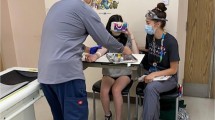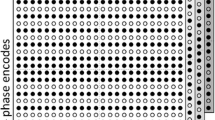Abstract
The high soft-tissue contrast of MRI and the absence of ionizing radiation make it a valuable tool for assessment of body pathology in children. Infants and young children are often unable to cooperate with awake MRI so sedation or general anesthesia might be required. However, given recent data on the costs and potential risks of anesthesia in young children, there is a need to try to decrease or avoid sedation in this population when possible. Child life specialists in radiology frequently use behavioral techniques and audiovisual support devices, and they practice with children and families using mock scanners to improve child compliance with MRI. Optimization of the MR scanner environment is also important to create a child-friendly space. If the child can remain inside the MRI scanner, a variety of emerging techniques can reduce the effect of involuntary motion. Using sequences with short acquisition times such as single-shot fast spin echo and volumetric gradient echo can decrease artifacts and improve image quality. Breath-holding, respiratory triggering and signal averaging all reduce respiratory motion. Emerging techniques such as radial and multislice k-space acquisition, navigator motion correction, as well as parallel imaging and compressed sensing reconstruction methods can further accelerate acquisition and decrease motion. Collaboration among radiologists, anesthesiologists, technologists, child life specialists and families is crucial for successful performance of MRI in young children.














Similar content being viewed by others
References
Karian VE, Burrows PE, Zurakowski D et al (2002) The development of a pediatric radiology sedation program. Pediatr Radiol 32:348–353
Malviya S, Voepel-Lewis T, Eldevik OP et al (2000) Sedation and general anaesthesia in children undergoing MRI and CT: adverse events and outcomes. Br J Anaesth 84:743–748
Arlachov Y, Ganatra RH (2012) Sedation/anaesthesia in paediatric radiology. Br J Radiol 85:e1018–e1031
American Academy of Pediatrics, American Academy of Pediatric Dentristry, Coté CJ et al (2006) Guidelines for monitoring and management of pediatric patients during and after sedation for diagnostic and therapeutic procedures: an update. Pediatrics 118:2587–2602
Khan JJ, Donnelly LF, Koch BL et al (2007) A program to decrease the need for pediatric sedation for CT and MRI. Appl Radiol 36:30–33
Arthurs OJ, Sury M (2013) Anaesthesia or sedation for paediatric MRI: advantages and disadvantages. Curr Opin Anaesthesiol 26:489–494
Edwards AD, Arthurs OJ (2011) Paediatric MRI under sedation: is it necessary? What is the evidence for the alternatives? Pediatr Radiol 41:1353–1364
Slovis TL (2011) Sedation and anesthesia issues in pediatric imaging. Pediatr Radiol 41:514–516
Mason KP, Michna E, DiNardo JA et al (2002) Evolution of a protocol for ketamine-induced sedation as an alternative to general anesthesia for interventional radiologic procedures in pediatric patients. Radiology 225:457–465
Sanborn PA, Michna E, Zurakowski D et al (2005) Adverse cardiovascular and respiratory events during sedation of pediatric patients for imaging examinations. Radiology 237:288–294
Creeley C, Dikranian K, Dissen G et al (2013) Propofol-induced apoptosis of neurones and oligodendrocytes in fetal and neonatal rhesus macaque brain. Br J Anaesth 110:i29–i38
Wilder RT, Flick RP, Sprung J et al (2009) Early exposure to anesthesia and learning disabilities in a population-based birth cohort. Anesthesiology 110:796–804
Rappaport BA, Suresh S, Hertz S et al (2015) Anesthetic neurotoxicity — clinical implications of animal models. N Engl J Med 372:796–797
Vanderby SA, Babyn PS, Carter MW et al (2010) Effect of anesthesia and sedation on pediatric MR imaging patient flow. Radiology 256:229–237
McGee K (2003) The role of a child life specialist in a pediatric radiology department. Pediatr Radiol 33:467–474
Goldberger GL, Wolfer J (1990) Helping children cope with health care procedures. Contemp Pediatr 7:141–162
Durand DJ, Young M, Nagy P et al (2015) Mandatory child life consultation and its impact on pediatric MRI workflow in an academic medical center. J Am Coll Radiol 12:594–598
Carbajal R, Chauvet X, Couderc S et al (1999) Randomised trial of analgesic effects of sucrose, glucose, and pacifiers in term neonates. BMJ 319:1393–1397
Harned RK 2nd, Strain JD (2001) MRI-compatible audio/visual system: impact on pediatric sedation. Pediatr Radiol 31:247–250
Courtier J, Cardenas A, Tan C et al (2015) Non-anesthesia MR enterography in very young children — feasibility, technique and performance. J Pediatr Gastroenterol Nutr 60(6):754–61. doi:10.1097/MPG.0000000000000712
De Bie HM, Boersma M, Wattjes MP et al (2010) Preparing children with a mock scanner training protocol results in high quality structural and functional MRI scans. Eur J Pediatr 169:1079–1085
Barnea-Goraly N, Weinzimer SA, Ruedy KJ et al (2014) High success rates of sedation-free brain MRI scanning in young children using simple subject preparation protocols with and without a commercial mock scanner — the Diabetes Research in Children Network (DirecNet) experience. Pediatr Radiol 44:181–186
Carter AJ, Greer ML, Gray SE et al (2010) Mock MRI: reducing the need for anaesthesia in children. Pediatr Radiol 40:1368–1374
Yang RK, Roth CG, Ward RJ et al (2010) Optimizing abdominal MR imaging: approaches to common problems. Radiographics 30:185–199
Chavhan GB, Babyn PS, Vasanawala SS (2013) Abdominal MR imaging in children: motion compensation, sequence optimization, and protocol organization. Radiographics 33:703–719
Ogden CL, Carroll MD, Kit BK et al (2014) Prevalence of childhood and adult obesity in the United States, 2011–2012. JAMA 311:806–814
Felmlee JP, Ehman RL (1987) Spatial presaturation: a method for suppressing flow artifacts and improving depiction of vascular anatomy in MR imaging. Radiology 164:559–564
Klessen C, Asbach P, Kroencke TJ et al (2005) Magnetic resonance imaging of the upper abdomen using a free-breathing T2-weighted turbo spin echo sequence with navigator triggered prospective acquisition correction. J Magn Reson Imaging 21:576–582
Vasanawala SS, Iwadate Y, Church DG et al (2010) Navigated abdominal T1-W MRI permits free-breathing image acquisition with less motion artifact. Pediatr Radiol 40:340–344
Wood ML, Runge VM, Henkelman RM (1988) Overcoming motion in abdominal MR imaging. AJR Am J Roentgenol 150:513–522
Epelman M, Dinan D, Gee MS et al (2013) Mullerian duct and related anomalies in children and adolescents. Magn Reson Imaging Clin N Am 21:773–789
Olpin JD, Heilbrun M (2010) Imaging of Mullerian duct anomalies. Top Magn Reson Imaging 21:225–235
Hennig J, Nauerth A, Friedburg H (1986) RARE imaging: a fast imaging method for clinical MR. Magn Reson Med 3:823–833
Katayama M, Masui T, Kobayashi S et al (2001) Fat-suppressed T2-weighted MRI of the liver: comparison of respiratory-triggered fast spin-echo, breath-hold single-shot fast spin-echo, and breath-hold fast-recovery fast spin-echo sequences. J Magn Reson Imaging 14:439–449
Dutka MV, Bergin D, O’Kane PL et al (2008) Rapid multiplanar abdominal survey using MRI with the steady-state free-precession technique. J Magn Reson Imaging 27:198–203
Malamateniou C, Malik SJ, Counsell SJ et al (2013) Motion-compensation techniques in neonatal and fetal MR imaging. AJNR Am J Neuroradiol 34:1124–1136
Pipe JG (1999) Motion correction with PROPELLER MRI: application to head motion and free-breathing cardiac imaging. Magn Reson Med 42:963–969
Forbes KP, Pipe JG, Bird CR et al (2001) PROPELLER MRI: clinical testing of a novel technique for quantification and compensation of head motion. J Magn Reson Imaging 14:215–222
Darge K, Anupindi SA, Jaramillo D (2011) MR imaging of the abdomen and pelvis in infants, children, and adolescents. Radiology 261:12–29
Hirokawa Y, Isoda H, Maetani YS et al (2008) MRI artifact reduction and quality improvement in the upper abdomen with PROPELLER and prospective acquisition correction (PACE) technique. AJR Am J Roentgenol 191:1154–1158
Chandarana H, Block TK, Rosenkrantz AB et al (2011) Free-breathing radial 3D fat-suppressed T1-weighted gradient echo sequence: a viable alternative for contrast-enhanced liver imaging in patients unable to suspend respiration. Invest Radiol 46:648–653
Glockner JF, Hu HH, Stanley DW et al (2005) Parallel MR imaging: a user’s guide. Radiographics 25:1279–1297
Keil B, Wald LL (2013) Massively parallel MRI detector arrays. J Magn Reson 229:75–89
Breuer FA, Blaimer M, Heidemann RM et al (2005) Controlled aliasing in parallel imaging results in higher acceleration (CAIPIRINHA) for multi-slice imaging. Magn Reson Med 53:684–691
Keil B, Alagappan V, Mareyam A et al (2011) Size-optimized 32-channel brain arrays for 3 T pediatric imaging. Magn Reson Med 66:1777–1787
Feinberg DA, Setsompop K (2013) Ultra-fast MRI of the human brain with simultaneous multi-slice imaging. J Magn Reson 229:90–100
Obele CC, Glielmi C, Ream J et al (2015) Simultaneous multislice accelerated free-breathing diffusion-weighted imaging of the liver at 3 T. Abdom Imaging 40:2323–2330
Vasanawala SS, Alley MT, Hargreaves BA et al (2010) Improved pediatric MR imaging with compressed sensing. Radiology 256:607–616
Zhang T, Chowdhury S, Lustig M et al (2014) Clinical performance of contrast enhanced abdominal pediatric MRI with fast combined parallel imaging compressed sensing reconstruction. J Magn Reson Imaging 40:13–25
Cheng JY, Zhang T, Ruangwattanapaisarn N et al (2015) Free-breathing pediatric MRI with nonrigid motion correction and acceleration. J Magn Reson Imaging 42:407–420
McDonald RJ, McDonald JS, Kallmes DF et al (2015) Intracranial gadolinium deposition after contrast-enhanced MR imaging. Radiology 275:772–782
Sadowski EA, Bennett LK, Chan MR et al (2007) Nephrogenic systemic fibrosis: risk factors and incidence estimation. Radiology 243:148–157
Ramalho M, Heredia V, de Campos RO et al (2012) In-phase and out-of-phase gradient-echo imaging in abdominal studies: intra-individual comparison of three different techniques. Acta Radiol 53:441–449
Mitchell CL, Vasanawala SS (2011) An approach to pediatric liver MRI. AJR Am J Roentgenol 196:W519–W526
Acknowledgments
We thank Shreyas Vasanawala, Jesse Courtier, Geetika Khanna, Sabah Servaes and Kawin Setsompop for providing images, and Katie Weagle for providing helpful suggestions on the manuscript.
Author information
Authors and Affiliations
Corresponding author
Ethics declarations
Conflicts of interest
The authors have no financial interests, investigational or off-label uses to disclose.
Rights and permissions
About this article
Cite this article
Jaimes, C., Gee, M.S. Strategies to minimize sedation in pediatric body magnetic resonance imaging. Pediatr Radiol 46, 916–927 (2016). https://doi.org/10.1007/s00247-016-3613-z
Received:
Revised:
Accepted:
Published:
Issue Date:
DOI: https://doi.org/10.1007/s00247-016-3613-z




